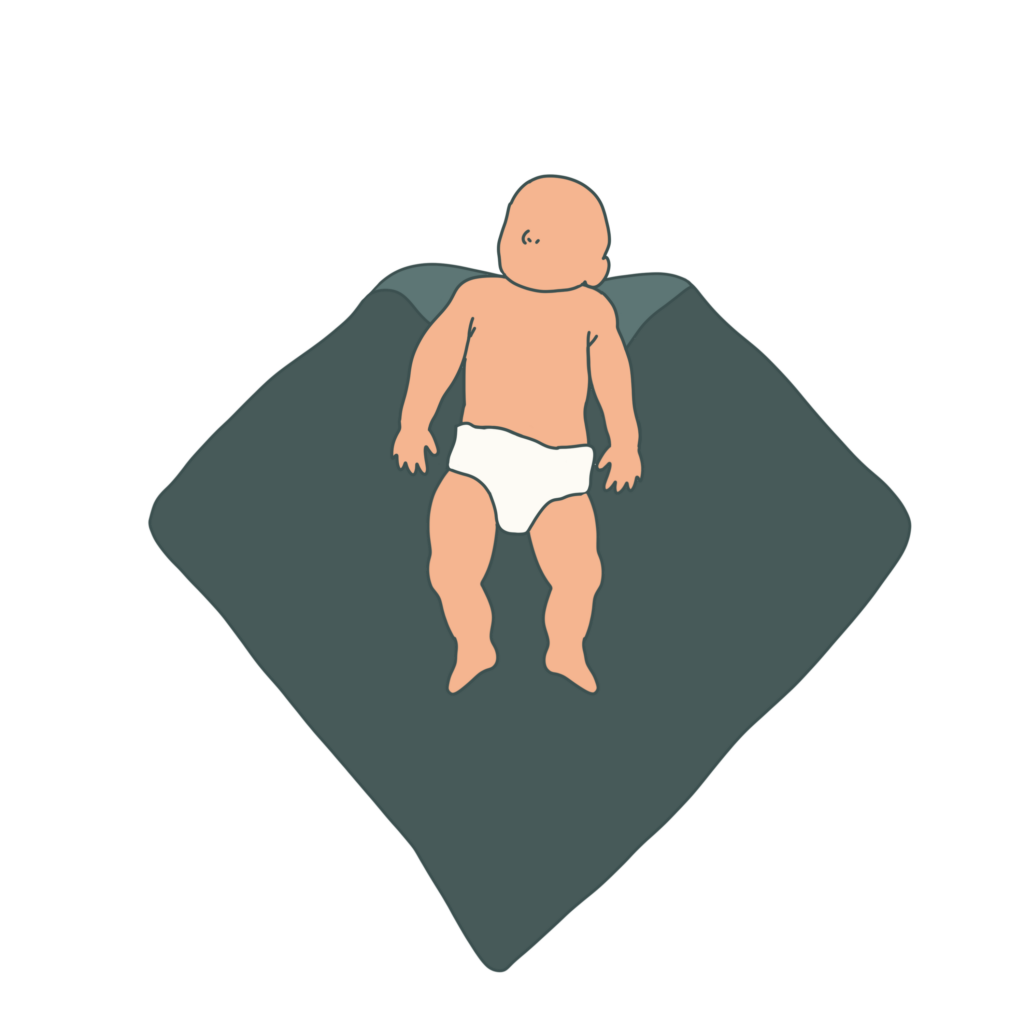
From life in the womb to life in the open air—it’s a completely different world! While your baby was warm and cozy in your belly, continuously rocked by your movements and the sounds of their cocoon, they suddenly find themselves far from these familiar sensations.
It’s no surprise, then, that your baby needs some time to adjust to this new world! To help them, you might have already heard about the swaddling “wild card”—let’s explore it together.
What are the benefits of swaddling for newborns?
Swaddling involves wrapping your baby snugly in a thin blanket or cloth to keep them contained and limit their movements. This technique can be highly beneficial for your child, although not all babies necessarily respond to it. Swaddling can be a lifesaver if your baby is sensitive to it!
Swaddling helps babies rediscover sensations similar to those experienced in the womb, helping to:
- keep them warm (reminding them of the warmth of your womb),
- meet their need for containment and comfort (the sensation of being snugly enclosed),
- calm their crying and help them fall asleep more easily (by providing familiar sensations),
- and even reduce waking caused by the Moro reflex (the newborn’s reflex that causes sudden spreading of arms and legs when they feel like they’re falling).
What’s the best technique for correctly swaddling your baby?
✅Step 1: Spread out a large cloth or blanket in a diamond shape and fold the top corner down. 
✅Step 2: Place your baby in the center, with their hands near their face and shoulders aligned with the fold made earlier (their face should never be covered).

✅Step 3: Fold their left arm so their hand is near their face, then wrap the left corner of the blanket over their left shoulder and tuck it beneath their right side.

✅Step 4: Repeat the same action for the right arm, bringing the fabric across their body and tucking it under their left side. Their hands should remain accessible, and their shoulders and hips comfortably secured.

✅Step 5: Twist the bottom corner of the blanket under their feet and tuck it beneath their back, ensuring your baby can straighten and move their legs freely (their movements shouldn’t be restricted).

At what age can you start swaddling a baby?
Swaddling helps provide reassurance to your baby right from the start of their life, facilitating the transition from womb to “the outside world.”
You can begin swaddling from birth. If your baby enjoys swaddling and feels comfortable with it, you can swaddle them several times a day!
In general, swaddling is intended primarily for sleep times or to help calm crying.
❗Above all, always swaddle your baby under your supervision!
Are there any risks associated with swaddling?
When swaddling your baby, certain precautions should be taken to avoid risks such as suffocation or overheating:
- Always place your baby on their back, never on their stomach (this is essential for swaddling and any other time),
- only swaddle under your supervision,
- make sure you can easily slide your hand between the blanket and your baby’s chest, and their legs can move freely,
- ensure their hips have freedom of movement,
- avoid overheating by using a lightweight fabric and regularly checking their temperature at the neck.
Want to learn more? Feel free to download the May app, where you’ll find plenty of resources to support and guide you throughout your journey as a new parent.
Which blankets are recommended for swaddling a baby?
To select the best swaddling blanket, consider the following points. The fabric should be:
- large enough to comfortably wrap your baby,
- diamond-shaped to make folding easier,
- lightweight, like jersey fabric or a large muslin cloth, to prevent overheating (definitely avoid thick blankets!).
Don’t forget to wash the cloth thoroughly before first use.
When should you stop swaddling your baby?
It’s recommended to swaddle your baby until they reach 2 months old at most.
Beyond this age, your baby gains mobility and risks rolling over, something that should absolutely not happen while swaddled (they don’t yet know how to lift their head using their forearms).
Moreover, while swaddled, your baby can’t learn to explore their own body and discover their physical abilities.
What are some alternatives to swaddling to help your baby sleep?
One of parents’ main concerns is getting their baby to sleep well. Newborn sleep can be restless, and that’s perfectly normal.
Besides swaddling, here are other tips to help your baby sleep:
- Rocking them: it reminds them of warmth and movement in the womb,
- Wait for a big sigh before placing them in bed after falling asleep in your arms—this marks the transition from light to deep sleep,
- Respect their sleep rhythms: don’t impose a schedule; let them sleep during the day if needed (unless medically indicated otherwise),
- Avoid letting them cry excessively; at this age, crying expresses a need (e.g., hunger),
- Carry them in your arms or a sling to provide security, helping them transition smoothly through sleep cycles,
- Place them near the crib’s sides to satisfy their need for containment,
- Make a small towel-roll under their mattress sheet, placed as a “U” under their hips,
- Warm the bed with a hot water bottle (reminding them of the womb’s warmth),
- Place your hand gently on them for reassurance after laying them down.
❗A baby’s mattress should always be firm and clear of objects to minimize SIDS risk.
Are you worried about creating bad sleep habits?
Many parents have this concern—rest assured, you won’t. Your baby is only a few months old and still needs you to fall asleep, which is entirely normal. Falling asleep in your arms does not create bad habits.
On the contrary, the more you respond to their need for emotional security, the more sleep becomes a calm, comforting experience, eventually giving them the confidence to fall asleep independently when they’re ready.
Swaddling and SIDS prevention: Is there a link?
Swaddling may soothe and reassure your baby, helping them sleep by providing a sense of containment similar to the womb. However, it’s crucial to do it only under supervision and not overnight while you sleep beside them.
In fact, good sleep practices are essential to reduce SIDS risks:
- A firm mattress (perfectly fitted to the bed),
- No soft items nearby (pillows, blankets, crib bumpers),
- Use a sleeping bag until about age two,
- No large stuffed animals (risk of suffocation),
- No smoke nearby,
- Maintain a bedroom temperature between 18-20°C,
- Always put your baby on their back.
The WHO also recommends sharing your bedroom with your baby for the first 6 months of life, particularly to facilitate breastfeeding and breathing regulation.
Thus, swaddling is beneficial under supervision and only up to 2 months of age.
This text was translated from French by an artificial intelligence. The information, advice, and sources it contains comply with French standards and may therefore not apply to your situation. Make sure to complement this reading by visiting the May US/UK app and consulting the healthcare professionals who are supporting you.




